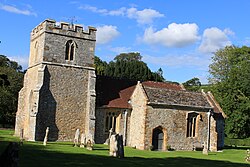Difference between revisions of "Melcombe Bingham"
(Created page with "{{Infobox town |name=Melcombe Bingham |county=Dorset |picture=Melcombe Horsey parish church 2015.JPG |picture caption=Melcombe Horsey parish church |os grid ref=ST762026 |lati...") |
m (→Parish church: clean up, replaced: medieval → mediæval) |
||
| Line 26: | Line 26: | ||
==Parish church== | ==Parish church== | ||
| − | The church of the parish of Melcombe Horsey is not found in Melcombe Bingham, the parish's only true village, but to the south-east, in the grounds of the manor house, Bingham's Melcombe. The remains of a deserted | + | The church of the parish of Melcombe Horsey is not found in Melcombe Bingham, the parish's only true village, but to the south-east, in the grounds of the manor house, Bingham's Melcombe. The remains of a deserted mediæval village lie to the south. |
The bells of the church are invoked by John Betjeman in his poem ''Dorset'': | The bells of the church are invoked by John Betjeman in his poem ''Dorset'': | ||
Latest revision as of 12:35, 30 January 2021
| Melcombe Bingham | |
| Dorset | |
|---|---|
 Melcombe Horsey parish church | |
| Location | |
| Grid reference: | ST762026 |
| Location: | 50°49’24"N, 2°20’18"W |
| Data | |
| Post town: | Dorchester |
| Postcode: | DT2 |
| Dialling code: | 01258 |
| Local Government | |
| Council: | Dorset |
Melcombe Bingham is a village in central Dorset, about ten miles northeast of Dorchester,[1] twelve miles south-east of Sherborne and eight mils west of Blandford Forum. It is within a wider parish known as Melcombe Horsey.
Melcombe Horsey parish has an area of 2,151 acres. Its population in 1871 was 190 and in 1911 only 151.[1] The parish church, St. Andrew's, is located at the south-eastern edge of the parish and its records date to 1690.[1]
The village is surrounded by chalk hills of the Dorset Downs, though the village itself is sited in a basin of greensand and gault.[2][3]
Names and manors
The names of places in this area are frequently muddled, with published sources providing different information.[1][4] Melcombe Bingham is the name of the current village, though in the fields near the church there is an abandoned mediæval village called Bingham's Melcombe, and this latter name is sometimes used to describe the church and its adjacent manor. Writing in 1980, writer Roland Gant stated "whichever form I use, I always find that the person to whom I am speaking uses the other".[5]
The name of both the ecclesiastical parish and the civil parish is 'Melcombe Horsey'.[1]
Parish church
The church of the parish of Melcombe Horsey is not found in Melcombe Bingham, the parish's only true village, but to the south-east, in the grounds of the manor house, Bingham's Melcombe. The remains of a deserted mediæval village lie to the south.
The bells of the church are invoked by John Betjeman in his poem Dorset:
Lord's Day bells from Bingham's Melcombe, Iwerne Minster, Shroton, Plush
Down the grass between the beeches, mellow in the evening hush.[6]
About the village
Bingham's Melcombe is a mediæval house, standing by the church to the south-east of the village. It takes its name from Robert Bingham who acquired the property through marriage in the 13th century. It remained in the Bingham family until 1895.[7] The house is believed to be early 16th century. It was substantially restored and remodelled in 1893-4 by Evelyn Hellicar (1862-1929)[8]
There is a second manor house within the parish, Higher Melcombe, two miles or so to the west in a coombe, forming a hamlet also named Higher Melcombe.[3][5]
Between the two manors is another settlement, situated along the road running north into the neighbouring parish of Hilton. This settlement is called either Hartfoot Lane or Ansty (including Lower Ansty, Ansty Cross, Higher Ansty, and Little Ansty), and at its southern end it merges into part of Melcombe Bingham.[3][4]
The deserted village of Melcombe Horsey stood gathered around where the church now stands, in Higher Melcombe.
Outside links
| ("Wikimedia Commons" has material about Melcombe Bingham) |
| ("Wikimedia Commons" has material about Melcombe Horsey) |
- St Andrew's, Melcombe Horsey:Dorset Churches
References
- ↑ 1.0 1.1 1.2 1.3 1.4 "Melcombe Horsey". Dorset OPC Project. http://www.opcdorset.org/MelcombeHorseyFiles/Melcombe%20Horsey.htm. Retrieved 28 March 2013.
- ↑ Melcombe Horsey: An Inventory of the Historical Monuments in Dorset, Volume 3,
- ↑ 3.0 3.1 3.2 Ralph Wightman (1983). Portrait of Dorset (4 ed.). Robert Hale Ltd. pp. 16, 109–110. ISBN 0 7090 0844 9.
- ↑ 4.0 4.1 Clive Hannay (June 2012). "Clive Hannay paints Ansty". Dorset Life Magazine. http://www.dorsetlife.co.uk/2012/06/clive-hannay-paints-ansty/. Retrieved 27 March 2014.
- ↑ 5.0 5.1 Roland Gant (1980). Dorset Villages. Robert Hale Ltd. p. 90. ISBN 0 7091 8135 3.
- ↑ John Betjeman's Collected Poems, 8th ed. (John Murray, 1980) pp. 40-41
- ↑ Historical Monuments in the County of Dorset, Vol III, Central, part 2, Royal Commission on Historical Monuments
- ↑ Builder LXVI, 24 March 1894, page 236